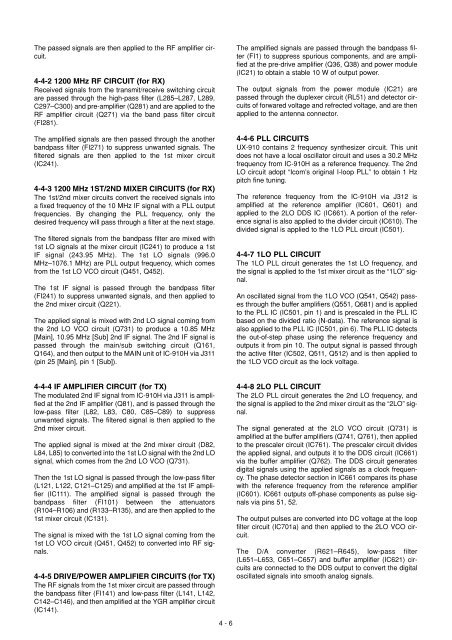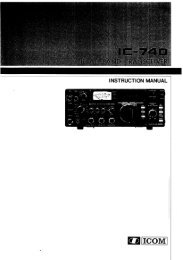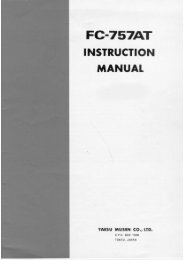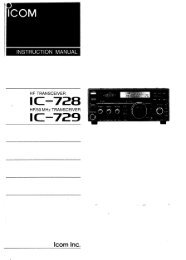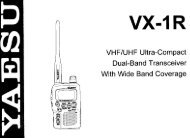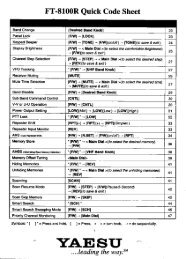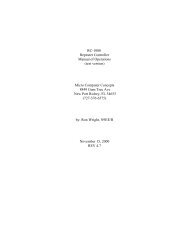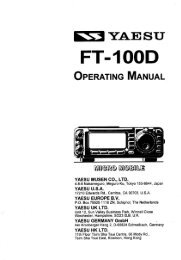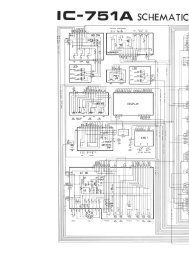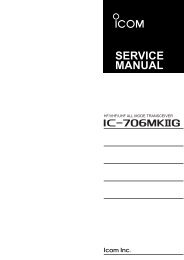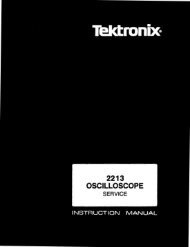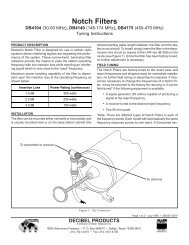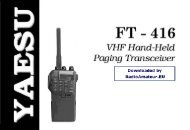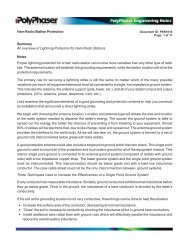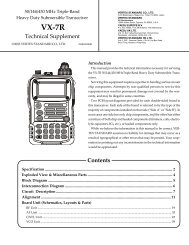You also want an ePaper? Increase the reach of your titles
YUMPU automatically turns print PDFs into web optimized ePapers that Google loves.
The passed signals are then applied to the RF amplifier circuit.<br />
4-4-2 1200 MHz RF CIRCUIT (for RX)<br />
Received signals from the transmit/receive switching circuit<br />
are passed through the high-pass filter (L285–L287, L289,<br />
C297–C300) and pre-amplifier (Q281) and are applied to the<br />
RF amplifier circuit (Q271) via the band pass filter circuit<br />
(FI281).<br />
The amplified signals are then passed through the another<br />
bandpass filter (FI271) to suppress unwanted signals. The<br />
filtered signals are then applied to the 1st mixer circuit<br />
(<strong>IC</strong>241).<br />
4-4-3 1200 MHz 1ST/2ND MIXER CIRCUITS (for RX)<br />
The 1st/2nd mixer circuits convert the received signals into<br />
a fixed frequency of the 10 MHz IF signal with a PLL output<br />
frequencies. By changing the PLL frequency, only the<br />
desired frequency will pass through a filter at the next stage.<br />
The filtered signals from the bandpass filter are mixed with<br />
1st LO signals at the mixer circuit (<strong>IC</strong>241) to produce a 1st<br />
IF signal (243.95 MHz). The 1st LO signals (996.0<br />
MHz–1076.1 MHz) are PLL output frequency, which comes<br />
from the 1st LO VCO circuit (Q451, Q452).<br />
The 1st IF signal is passed through the bandpass filter<br />
(FI241) to suppress unwanted signals, and then applied to<br />
the 2nd mixer circuit (Q221).<br />
The applied signal is mixed with 2nd LO signal coming from<br />
the 2nd LO VCO circuit (Q731) to produce a 10.85 MHz<br />
[Main], 10.95 MHz [Sub] 2nd IF signal. The 2nd IF signal is<br />
passed through the main/sub switching circuit (Q161,<br />
Q164), and then output to the MAIN unit of <strong>IC</strong>-<strong>910H</strong> via J311<br />
(pin 25 [Main], pin 1 [Sub]).<br />
The amplified signals are passed through the bandpass filter<br />
(FI1) to suppress spurious components, and are amplified<br />
at the pre-drive amplifier (Q36, Q38) and power module<br />
(<strong>IC</strong>21) to obtain a stable 10 W of output power.<br />
The output signals from the power module (<strong>IC</strong>21) are<br />
passed through the duplexer circuit (RL51) and detector circuits<br />
of forwared voltage and refrected voltage, and are then<br />
applied to the antenna connector.<br />
4-4-6 PLL CIRCUITS<br />
UX-910 contains 2 frequency synthesizer circuit. This unit<br />
does not have a local oscillator circuit and uses a 30.2 MHz<br />
frequency from <strong>IC</strong>-<strong>910H</strong> as a reference frequency. The 2nd<br />
LO circuit adopt “Icom’s original I-loop PLL” to obtain 1 Hz<br />
pitch fine tuning.<br />
The reference frequency from the <strong>IC</strong>-<strong>910H</strong> via J312 is<br />
amplified at the reference amplifier (<strong>IC</strong>601, Q601) and<br />
applied to the 2LO DDS <strong>IC</strong> (<strong>IC</strong>661). A portion of the reference<br />
signal is also applied to the divider circuit (<strong>IC</strong>610). The<br />
divided signal is applied to the 1LO PLL circuit (<strong>IC</strong>501).<br />
4-4-7 1LO PLL CIRCUIT<br />
The 1LO PLL circuit generates the 1st LO frequency, and<br />
the signal is applied to the 1st mixer circuit as the “1LO” signal.<br />
An oscillated signal from the 1LO VCO (Q541, Q542) passes<br />
through the buffer amplifiers (Q551, Q681) and is applied<br />
to the PLL <strong>IC</strong> (<strong>IC</strong>501, pin 1) and is prescaled in the PLL <strong>IC</strong><br />
based on the divided ratio (N-data). The reference signal is<br />
also applied to the PLL <strong>IC</strong> (<strong>IC</strong>501, pin 6). The PLL <strong>IC</strong> detects<br />
the out-of-step phase using the reference frequency and<br />
outputs it from pin 10. The output signal is passed through<br />
the active filter (<strong>IC</strong>502, Q511, Q512) and is then applied to<br />
the 1LO VCO circuit as the lock voltage.<br />
4-4-4 IF AMPLIFIER CIRCUIT (for TX)<br />
The modulated 2nd IF signal from <strong>IC</strong>-<strong>910H</strong> via J311 is amplified<br />
at the 2nd IF amplifier (Q81), and is passed through the<br />
low-pass filter (L82, L83, C80, C85–C89) to suppress<br />
unwanted signals. The filtered signal is then applied to the<br />
2nd mixer circuit.<br />
The applied signal is mixed at the 2nd mixer circuit (D82,<br />
L84, L85) to converted into the 1st LO signal with the 2nd LO<br />
signal, which comes from the 2nd LO VCO (Q731).<br />
Then the 1st LO signal is passed through the low-pass filter<br />
(L121, L122, C121–C125) and amplified at the 1st IF amplifier<br />
(<strong>IC</strong>111). The amplified signal is passed through the<br />
bandpass filter (FI101) between the attenuators<br />
(R104–R106) and (R133–R135), and are then applied to the<br />
1st mixer circuit (<strong>IC</strong>131).<br />
The signal is mixed with the 1st LO signal coming from the<br />
1st LO VCO circuit (Q451, Q452) to converted into RF signals.<br />
4-4-5 DRIVE/POWER AMPLIFIER CIRCUITS (for TX)<br />
The RF signals from the 1st mixer circuit are passed through<br />
the bandpass filter (FI141) and low-pass filter (L141, L142,<br />
C142–C146), and then amplified at the YGR amplifier circuit<br />
(<strong>IC</strong>141).<br />
4 - 6<br />
4-4-8 2LO PLL CIRCUIT<br />
The 2LO PLL circuit generates the 2nd LO frequency, and<br />
the signal is applied to the 2nd mixer circuit as the “2LO” signal.<br />
The signal generated at the 2LO VCO circuit (Q731) is<br />
amplified at the buffer amplifiers (Q741, Q761), then applied<br />
to the prescaler circuit (<strong>IC</strong>761). The prescaler circuit divides<br />
the applied signal, and outputs it to the DDS circuit (<strong>IC</strong>661)<br />
via the buffer amplifier (Q762). The DDS circuit generates<br />
digital signals using the applied signals as a clock frequency.<br />
The phase detector section in <strong>IC</strong>661 compares its phase<br />
with the reference frequency from the reference amplifier<br />
(<strong>IC</strong>601). <strong>IC</strong>661 outputs off-phase components as pulse signals<br />
via pins 51, 52.<br />
The output pulses are converted into DC voltage at the loop<br />
filter circuit (<strong>IC</strong>701a) and then applied to the 2LO VCO circuit.<br />
The D/A converter (R621–R645), low-pass filter<br />
(L651–L653, C651–C657) and buffer amplifier (<strong>IC</strong>621) circuits<br />
are connected to the DDS output to convert the digital<br />
oscillated signals into smooth analog signals.


